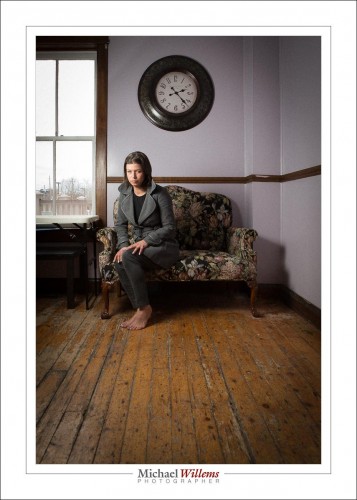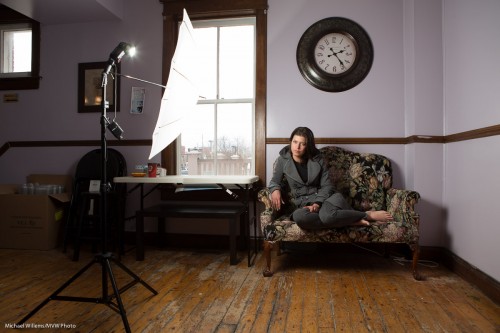Shot of the day: Impatient Young Woman in Somewhat Victorian Setting, 26 April 2014 in Whitby, Ontario:
Canon 1Dx, 24-70 lens,. 200 ISO, 1/200 sec, f/5.6
A shot like this requires a few decisions.
One: the light. Available light? Easy, but if I want the window in the picture, it is difficult, because the model will be dark, or the window blown out. So I add a flash, so that I can get both done. I use an umbrella so that I get soft light, and I position it carefully to emphasize the subject. and not over-light the background. Meaning, close to the subject.
Then, the lens. Close, or wide? When I see lines like the lines on the floor here, I want to make them into converging lines leading to the subject.. so I use a wide lens. This gives me a wonderful composition where the environment plays a definite role.
The composition: I want to include that floor, but also the clock and part of the window. I want to use the Rule of Thirds. Knowing that, the composition falls into place.
The setup was like this:
The flash was fired with Pocketwizard radio triggers, and was set to MANUAL mode, at one quarter power. I can meter that with my flash meter, or use experience plus trial and error. Moving the flash 40% farther away is one stop less light; 30% closer is one stop more. (Why those numbers, math buffs? Answer after the line.)
Finally, post work. In this case, I think colour is called for:it adds to the image, so no black and white conversion is needed. I add a slight vignetting perhaps, and I straighten the verticals if needed, and if I get the settings right (which I did), then not much else is needed.
Moving the flash 40% farther away is one stop less light; 30% closer is one stop more. Why those numbers?
Inverse square law.
- The square root of 2 is 1.414… so 40% farther is the square root of 2 farther, which gives you “the square of the square root of 2″ less light. The square of the square root of 2 is of course 2: twice the light means one stop more light. Hence, 40% farther gives you one stop less light.
- 1 divided by the square root of 2 is 0.70… if I bring the flash to 0.7 of its previous distance, I get “the square of1 divided by the square root of 2″ more light. The square of 1 divided by the square root of 2 is of course 1 divided by 2. Which means one half, which is one stop more light. Hence, 30% closer gives you one stop more light.
Can you see how cool it is if you know some very basic high school math? Do not be scared. This is really not high school stuff: kids learn about square roots in 4rd or 5th grade I believe.



sweet shot, and explain michael – hope to take your flash workshop
Happy to explain: ask detailed questions and I always answer. And I hope to see you on the course, Carl. See http://learning.photography for some options!